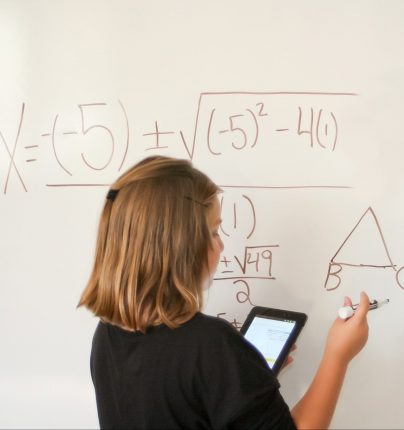While I have one child who memorized all of his math facts at age five, none of the others have taken to them as easily. There are many different types of kids and just as many different ways to tackle those facts.
First, though, you may wonder if it’s worth the effort in the computer age to drill and memorize math facts. What you need to understand is that math facts are the phonics of the language of mathematics. Just like knowing the alphabet doesn’t make a fluent reader, you’ll never have a fluent mathematician if your child never learns how those numbers go together. Phonics is the tool that takes those letters and makes them mean something. Fluency is achieved through exposure and practice and is an essential step in reading comprehension. Math fact fluency is the first step in your child’s ability to understand the language of math. Fractions and equations lose meaning without this building block in place.
Math facts are introduced with objects and concrete examples of what is happening when we add, subtract, multiply and divide, and chocolate chips are great tools for such lessons, but the goal is for the answers to become automatic, to achieve fluency.
If your child has logic smarts and thinks math is a lot of fun, learning math facts should be pretty easy and even enjoyable, but there are lots of other kinds of kids. Children shouldn’t feel that they don’t “speak” math. They all have the smarts they need to become fluent, successful mathematicians. Here are some ideas to help them learn the basic language of math.
Music smarts: Write songs to practice facts, or find rhymes online or in books and put them to a melody.
Art smarts: Write a math fact equation on a piece of paper. Use lots of color and change the numbers into characters or pictures. Hang them up or make a book of them.
Body smarts: Instead of writing the answers, jump the answers (ie. jump six times for the answer six). They can clap, flap wings, wiggle, raise shoulders, touch toes, turn around, do jumping jacks, etc. to show the number of the answer.
Word smarts: Write or read stories that feature math facts. For instance, “I ate six chocolate bars four times and was sick for twenty-four hours.” “I found six blue rubber bands in the street and then found four red ones and put one around each of my ten toes.”
People smarts: Recruit family and friends to remind your child of the facts and to do impromptu practice and oral quizzes.
Maybe your child would just like a motivation. I learned my multiplication facts in one day in third grade because the teacher promised an ice cream sandwich to the first in the class to do it. I still find ice cream to be a good motivator!
Lee Giles is a homeschool mother of six. She and her husband have served the Lord overseas for more than a decade. She is the creator of the Easy Peasy All-in-One Homeschool which provides 180 days of engaging assignments in all subjects and for all levels from preschool through high school. Her commitment to free, high quality education has enabled thousands of families to homeschool, many of whom otherwise thought it was impossible.
Latest Posts

While nearly every college and university today is eager to accept homeschooled students into their institutions, homeschooling families need to understand that their student’s application…
Read more >
Guest Post by Gabriel Morse For several years, I sat for long hours every day behind one of those battleship gray desks in a windowless, dull, gray office. The pay was enough to take care…
Read more >
This post is sponsored by Little Monsters Universe. I'm Tina Salmanowitz, an advocate for homeschooling and science education. With over a decade of experience as a science educator (in class…
Read more >


